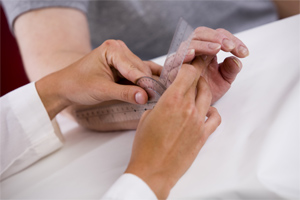Chiropractic for Carpal Tunnel Syndrome
Carpal Tunn el Syndrome (CTS), named from the carpal bones in the wrist that form a tunnel around the nerve leading to the hand, is an injury usually caused by repetitive and forceful movements that result in swelling around the tendons and pinching of the median nerve, causing painful tingling, lack of muscle strength and control in the hand, and pain shooting from the hand up to the shoulder. CTS is a risk to most workers, such as those who work on the computer and also store and assembly line workers, who receive micro-traumas to their hands and wrists on a daily basis due to awkward positioning, forceful and repetitive movements, and stressful activity.
el Syndrome (CTS), named from the carpal bones in the wrist that form a tunnel around the nerve leading to the hand, is an injury usually caused by repetitive and forceful movements that result in swelling around the tendons and pinching of the median nerve, causing painful tingling, lack of muscle strength and control in the hand, and pain shooting from the hand up to the shoulder. CTS is a risk to most workers, such as those who work on the computer and also store and assembly line workers, who receive micro-traumas to their hands and wrists on a daily basis due to awkward positioning, forceful and repetitive movements, and stressful activity.
The usual treatment for Carpal Tunnel Syndrome can extend to heavy medication and surgery, however there are alternative methods of treatment that can alleviate the symptoms and effects arising from CTS. Chiropractic treatment for CTS has been studied against conventional non-surgical medical treatment and was found to be effective. This offers an alternative to sufferers who are intolerant to ibuprofen, or those who simply wish to avoid treating with medication.
The median nerve in the wrist, which when trapped causes Carpal Tunnel Syndrome, connects to the spinal cord through the openings in the bones in the areas around the lower neck. If these bones in the spinal cord lose their ordinary position or motion, this can cause problems in the wrists or fingers. Through chiropractic treatment, these bones can be reset to the correct position and can help to treat CTS.
If Carpal Tunnel Syndrome is detected early, then surgery can be avoided, and chiropractic treatment is the leading method of non-surgical treatment. Chiropractic treatment usually involves various methods, with a combination of rest, ice, ultrasound, and electrical stimulation, including:
* By chiropractic manipulation therapy of the elbow and upper spine, where the joint’s soft tissue undergoes manipulation;
* Nutritional supplements in the diet such as B6, a vitamin that has had long-term promotion in its treatment of CTS;
* Electro-acupuncture treatment; bracing, a technique that has had extensive success, by limiting extension and flexion in the hand, and with compression on the median nerve may encourage recovery and ease the swelling in the tendons;
* Exercises for the wrist and hand designed to encourage recovery;
* Reassessing the ergonomics of the work place to minimize stress the best way as possible.
Recent studies concluded that using manual therapy intervention such as soft tissue mobilization (STM) has been found to help improve the signs and symptoms of CTS, with improvements to nerve conduction latencies, wrist strength and motion.
Carpal Tunnel Syndrome can become a serious health problem, and if left too long may require surgery. If it’s caught early, then chiropractic treatment is an effective, drug-free method to ease the symptoms and pains caused by CTS, and provide long-term relief from CTS.
Every body is different. If you have questions about this article or whether chiropractic is an appropriate choice for your specific situation, please ask. We are here to help!








